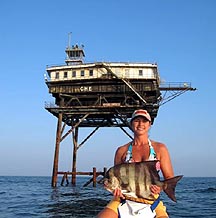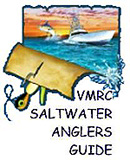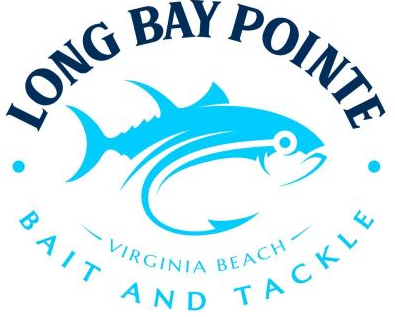
Approximately thirteen miles off the beautiful mid-Atlantic shores of Virginia Beach, Virginia stands a solitary light tower dutifully guarding the mouth of the flourishing Chesapeake Bay. Appropriately named the Chesapeake Light Tower, this key aid to navigation has served as a guiding beacon for maritime vessels for over 40 years. This historic tower has also earned the fitting reputation as a thriving seasonal host for an assortment of structure-oriented fish, the most popular of which is called the Atlantic spadefish.
A Little History
Most local anglers are not aware that thirty years prior to the erection of the well known light tower, the navigational task of directing traffic approaches to the Chesapeake Bay were the responsibility of a seagoing lightship station called Lightship 116, assigned to the entrance of the bay by the US Lighthouse Service. In the approximate location where the tower currently hovers 120 feet above sea level, the well-equipped 133-foot lightship vessel stood watch from 1933 until it was reassigned to guide traffic into the Delaware Bay. Sporting a bright red hull, suitably adorned with the word “Chesapeake” in huge white letters, the all-steel constructed Lightship Chesapeake was exceptionally seaworthy, enabling the ship to remain on station during the most adverse of weather conditions, including three full-strength hurricanes!
Completed in 1965, the more cost effective light tower replaced the faithful Lightship Chesapeake after 32 years of service. This new tower was a high-tech offshore tower patterned after the “Texas-style” oil drilling platforms. Extremely sturdy, Chesapeake Light is supported by four concrete-filled steel legs buried 180 feet within the ocean floor, designed to withstand the violent sea conditions frequently presented by the treacherous mid-Atlantic waters. Originally manned by a team of four, the tower was eventually converted into an automated station, which now provides data collection for various scientific research projects, as well as sea and weather conditions as an integral link to the NOAA marine reporting system.
A Fish Haven
Although the Chesapeake Light Tower is acknowledged as an exceptional source of structure for aquatic life, the tower itself is actually situated among acres of scattered wreckage and manmade reefs. In effect, the Chesapeake Light stands as “king” over its expansive graveyard of sunken barges, box cars, tires, tug boats, and entangled masses of steel. To the delight of anglers, this submerged array of structure provides a perfect kingdom for a community of different fish species, including black sea bass, flounder, tautog, triggerfish, king mackerel, Spanish mackerel, and even super-sized cobia.
The supporting framework of the light tower also graciously hosts a mixture of seasonal species. The first of these eagerly anticipated guests arrives as the mild spring air gently erases the chill from the cool ocean waters. The debut of the earliest of the three main tower visitors, the graceful Atlantic spadefish, is warmly welcomed by eager Virginia anglers. As the spades engage the full attention of very content fishermen, the onset of summer will boldly threshold the entrance of the tower’s next seasonal guest, the emperor of all wrecks, the mighty amberjack. These massive jacks offer an uncompromising battle to those brave anglers who dare to wrestle with the overpowering beasts, which more often than not results in a trail of broken fishing line among the unforgiving tower legs. And last but not least, making its entrance quietly around September, the humble cousin of the amberjack, the jack crevelle, will choose the alluring tower framework as its humble abode for the duration of the fall. Certainly an impressive combination, this trio will rule the tower until late fall, at which time they will silently slip into the depths seeking more temperate waters.
The Atlantic Spadefish
If you ask any local saltwater angler, they can confirm that the prized Atlantic spadefish is irrefutably responsible for sustaining the Chesapeake Light Tower on Virginia’s fishing map. Dwelling around most any type of structure, spades are found all along the East coast, as well as the warm waters of the Gulf of Mexico. Considered mostly a nuisance in the Gulf, in Virginia waters, as with most fish in these parts, spadefish grow to exceptional sizes, earning a reputation as one of the most challenging fighters anglers will ever come across.
Although these elegant schooling fish have inhabited East coast waters for years, surprisingly, the now-thriving fishery has really only evolved within the last 10 years. Today, the spadefish is the one of the most anticipated fish in Virginia, thrilling anglers of all skill-levels. Each spring, as the first reports of spadefish sightings at the light tower hit the streets, the rush to intercept these summertime celebrities is utter chaos.
The average resident Virginia spade generally ranges between about 4 to 7 pounds, with many topping well over ten pounds! It’s not surprising that the massive current 14-pound world record was caught in Virginia waters. There is no mistaking a spadefish; they are distinctive beauties, with a tall flat torso glowing with an iridescent sliver color, interrupted by five or more vertical black stripes. So make sure you have your camera handy, but don’t let their charming poise and splendor catch you off guard, be warned, these fish will keep you on your toes! Stand ready for a swift, powerful creature that is quick to outsmart even the most experienced angler, leaving you with nothing to show but a broken leader. The wide-eyed look of astonishment once beaten by a spadefish is amusing, but very common. Once conquered though, your reward is by far one of the tastiest fish in the ocean.
Timing
Once arriving at the Chesapeake Light, there is little doubt of their presence, as evidenced by a solid blacked-out bottom machine, and huge schools of graceful spadefish gliding past your boat with no particular agenda. The best time to target these fish is from about mid May through late August.
As with any species, the spadefish’s feeding patterns vary, but I have noticed little difference in timing for spadefish appetites-either they will bite or they won’t. But when the sun sits higher in the sky, the fish do tend to sound somewhat deeper in the water column, so following the fish with deeper placement of the bait will prove a little more productive around midday. The movement of the tides and currents do not seem to have much bearing on the bite, unless the current is running hard enough to hinder a natural bait presentation.
The best approach to a successful spadefish outing is to anchor in the vicinity of their holding structure. There is no need to anchor too close to the leader-breaching Light Tower, but also avoid positioning your boat near any other ominous fixtures such as, anchor ropes, buoys, nearby boat out drives, and neighboring angler’s baits. If you forget, you will be boldly reminded soon enough!
Bait
What in the world do spadefish eat? Well, their favorite treat is by far is the common jellyfish. But luckily, the easily obtainable chowder clam pulls in as a close second choice. I have tried other baits, and heard of others with some success, but chowders are plentiful and inexpensive, and entice the spades every time. But be sure to leave the dock with plenty of them, at least two or more dozen clams per person, but the more the better. In addition to the bait, be sure to grab a few packs of spadefish chum! Tackle shops sell clam chum in a variety of frozen forms, and is an excellent method of luring the spades closer to your bait, and hold them near your boat. So grab your clams, tackle, and chum, and point your bow to the east towards the Chesapeake Light Tower, the king of the spades.
Once anchored, jump-start the action by tying the clam chum over the side of the boat, and whacking a few chowders firmly together and discarding the shells. Spadefish are extremely curious, and are often attracted by this effort, playfully chasing your discarded shells out of sight. Prepare the bait by slicing the clam into two or three strips from the belly towards the foot section. The method of baiting the hook varies, but my best luck comes with the clam threaded on belly first, leaving the foot to barely cover the barb of the hook. No matter which baiting technique you use, be mindful that spadefish are expert bait snatchers!
Tackle and Equipment
Keeping in mind the strength and agility of these powerful fighters, leave your light tackle at the dock. Four medium-action rods with matching spinners or bait casters will usually suffice. My favorite combos include custom 6-foot rods paired with a Calcutta 400, and my trusty Stradic 4000, both strung with either 20-pound monofilament or Power Pro braided line. Whatever your choice, ensure your equipment is in optimal working order, these are no wimpy fish, and will test your equipment’s worthiness in a hurry. As for terminal tackle, after encountering endless broken hooks and leaders, I have found 3-4 feet of 20-pound disappearing pink Yo-Zuri fluorocarbon leader tied to a small barrel-swivel, to be the best option. Line any heavier than this, and the spadefish tend to become more leader-shy, any lighter and you can count on retying your broken rig.
A small, very strong, sharp hook is an absolute must with spadefish. A spade’s mouth is no larger than a marble, and loaded with leader-abrading teeth strong enough to effortlessly fracture any average-strength hook. Therefore, for strength and sharpness, my top choice is a #1 or #2 Gamakatzu live-bait hook. Because the leaders are easily frayed and weakened during the battle with these dynamos, I recommend having dozens of rigs tied ahead of time and ready to go. It’s a shame to miss out on optimum fishing time while retying lost hooks and frayed line.
Setup and Technique
I never set out more than four rods, any more and you are asking for a spadefish-twister game in the cockpit, with fish lost during the tangle. Verify you have plenty of room for long runs, the Chesapeake Light Tower grounds tend to materialize into a boat parking lot when the spades are in town. Two of the rods are donned with a small ¼-½ ounce egg sinker sitting above the barrel swivel with a float set 2 to 4 feet above the sinker. The other two rods consist of the same arrangement, minus the floats. Drift the two lines with floats back behind the boat, anywhere from 20–40 feet is a good starting point. Place the other two lines directly behind the boat, lowering one until the bait just disappears, and the other to about 8 feet or so. As it becomes evident which depths and arrangements are preferred, adjust your spread accordingly. Place the rods in the rod holders, and tighten the drag on the reels until you can just pull the line, then sit back and wait. Resist the urge to hold the rod, which is a sure way to miss the bite, and ignore any nibbles. Don’t get too comfortable though; as soon as those nibbles transpire into a doubled-over rod, be my guest. But be prepared for a battle that attracts anglers from all over to the famous Chesapeake Light Tower, for your opponent is the compact-sized beauty with a powerful punch unmatched by any other…the commanding spadefish.










 Views Last 7 days : 1855
Views Last 7 days : 1855 Views Last 30 days : 8771
Views Last 30 days : 8771